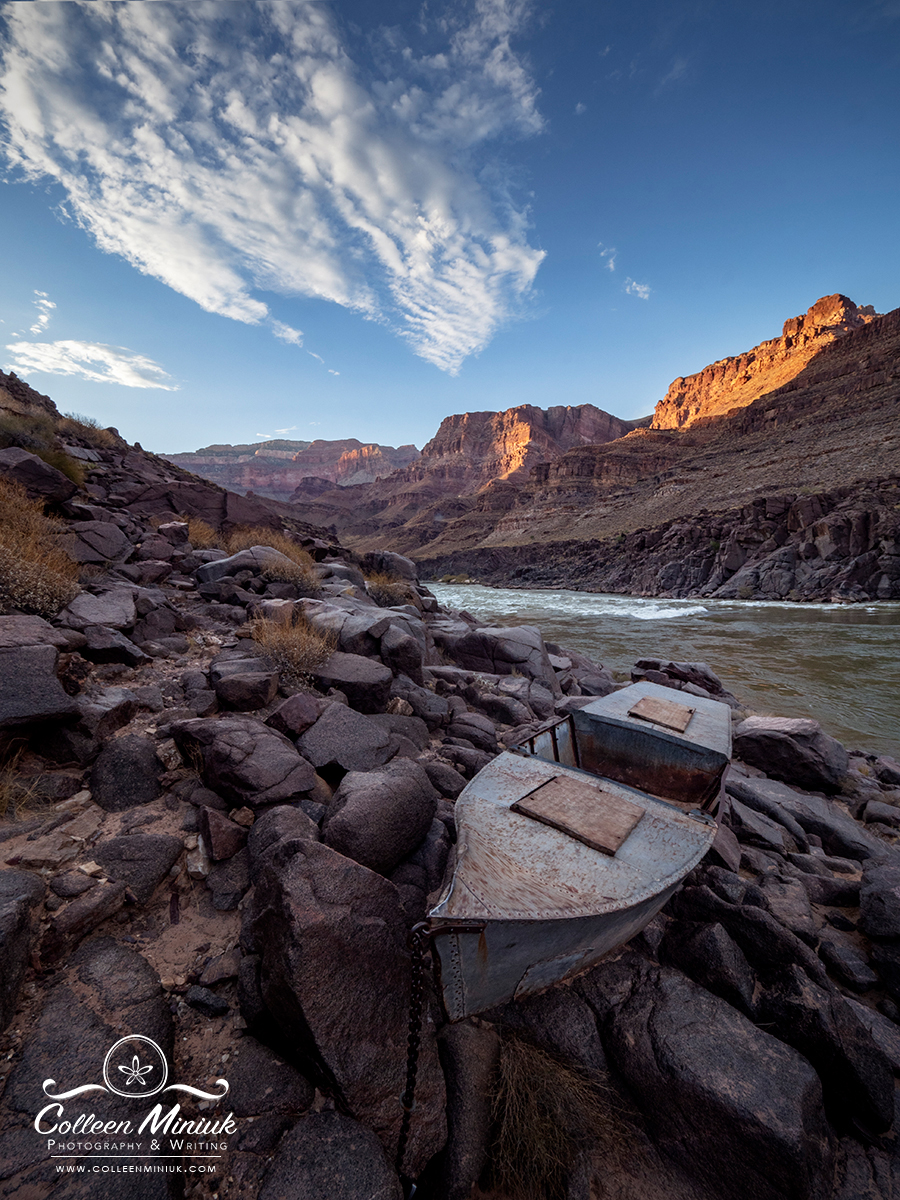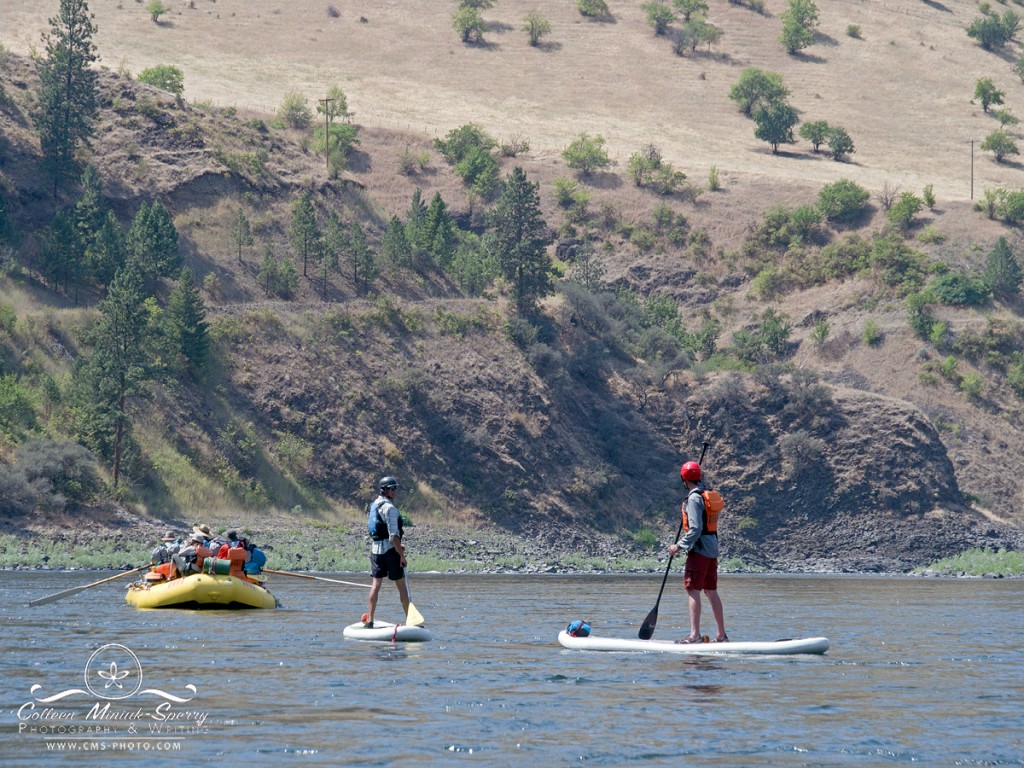The Tale of the Colorado River Croc
(or, How I’ll Never Forget the Line through Lava Falls)
I could start this story in the traditional way, with “Once upon a time” or “Long ago, in a faraway land.” But I’m a river guide in training. I’ve learned to start all river stories with “NO SHIT! This really happened!”
So: NO SHIT! This really happened!
There I was, just another speck of sand clinging to a thirty-five-foot motorized boat at the bottom of the Grand Canyon. I wasn’t alone. The boatman, Lars, and the swamper, Josh, were in charge of the eight-day operation, both guides from Hatch River Expeditions, the commercial outfit I had hired for a private charter.
I was on board as the photography guide and instructor. I had convinced fifteen unsuspecting guests to join me on a trip called “the Grand Canyon Rafting Photography Retreat.” “It’s such a cool trip,” I had said to lure them in. When Lars motored us into our overnight camp around river mile 159—159 miles into our 188-mile trip—it was 108 degrees Fahrenheit. “That is cool,” I told them. “I mean, compared to yesterday’s 113 . . .”
In the shadow of a thousand-foot cliff, Lars shooed us off his boat, and onto a series of long, narrow, stair-stepped ledges made of black and beige Tapeats Sandstone. Our camp for the night. The place didn’t have a name. It was a wide spot in the canyon just big enough to fit a kitchen, a groover, sleeping cots organized in two rows on rock shelves stacked like bleachers, and a yard-sale assortment of clothes and camera gear. After we unpacked the boat, Lars pointed out the high-water line, which doubled as the “don’t-camp-below-here-or-you’ll-die” line. Four of us took three steps back. A voice from the back suggested we name this prime riverside property “Lars’s Ledges” (which wasn’t to be confused with The Ledges, a formal camp upstream near river mile 152). We were all living like Lars now, like real river guides: living on the edge by living on the ledge.
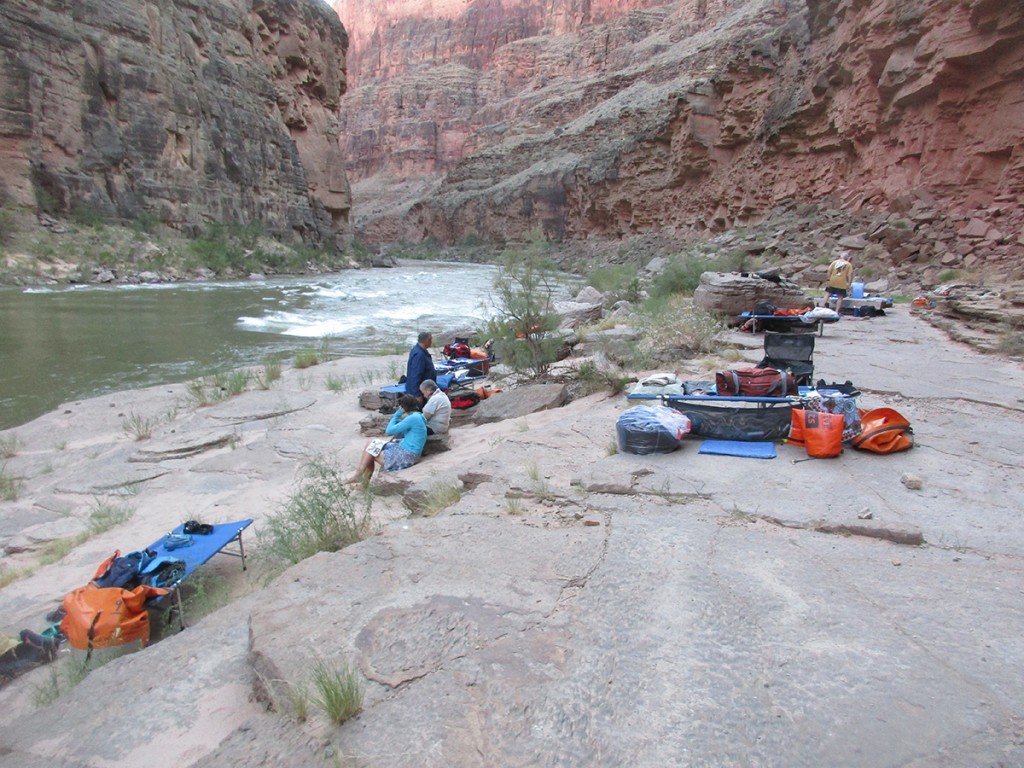
PHOTO: Camping on Lars’s Ledges. Photo courtesy of Jacque Miniuk.
The late afternoon sun started tracing the backbones of ocotillo-lined ridgelines and spotlighting distant serrated spires. A sign from the river gods to commence the Ritual of Noctis. Change into camp clothes (a fancy term for pajamas you’ve worn for six nights straight). Set up cot. Wash hands. Eat. Clean dishes. Brush teeth. Check under cot for rattlesnakes. Pour sand out of shoes. Then, as the sliver of sky overhead sings its soothing lullaby from cobalt to navy to purple to black, fall asleep.
As I neared the end of this evening’s ceremony, I wasn’t tired. Neither were the guides. Josh invited me to join him and Lars for a rendezvous on the boat where they slept. This was my fourth trip with Lars, my second with Josh, but I still felt like I had been summoned to the popular kids’ table at a high school cafeteria.
I bounced across the unloaded S-rig, feeling my way in the dark by memory around the oblong-shaped doughnut and long, torpedo-like tubes attached on either side like outrigger pontoons. I found a perch on top of a metal food box in the back of the boat. I took my shoes off, my cyan-colored Crocs, and set them next to me. My feet dangled inside the floorless raft, where I could hear, but not see, the Colorado River rushing beneath me.
Earlier versions of these “baloney boats” had sealed floors and thus were not self-bailing. Assistant crewmembers used buckets to remove water from the boats so they wouldn’t sink in the rapids. These lucky individuals were known as “swampers.” Even though the Grand Canyon Expeditions founder Ron Smith ripped out the floor years ago—a design known now as the self-bailing “S-rig,” the “s” for Smith—the term “swamper” lives on. Before you ever think of becoming a head boatman, you have to do time as the swamper, at the beck and call of the boatman. On this trip, in addition to leading the photography activities, I was the swamper to the swamper. I was doing double time.
“Wanna beer, swamper?” Josh asked me. Lars didn’t drink.
“Is the pope Catholic?” I said, turning toward the sound of his voice.
He opened the cooler.
CLUNK!
“What was that?” Josh asked.
I had no idea. I couldn’t see anything other than a faint V-shaped silhouette of the canyon walls and stars sparkling overhead. I turned on my headlamp.
“Where’s my shoe?” I spotted my left Croc on the food box beside me, but not my right. “I think that was my shoe.”
“Oh, that shoe is gone,” Josh said, handing me a cold one.
“If you fell in here without a life vest, you’d die,” Lars’ voice boomed in the dark from across the boat. His 280-plus trips down the river had worn him into a realist. “Maybe you’d resurface ten days later downstream like dead bodies do. Probably after Lava Falls somewhere. Or maybe you’d just stay in the river. Yeah, that shoe is gone.”
I took a long swig of beer. Josh did the same. I shrugged and said, “It could have been worse. It could have been the beer.”
“The first rule of being a river guide is to keep your shoes on your feet,” Lars said. “If you step on a stick and it goes through your foot, or you get even a simple infection, you’re getting helicoptered out. Trip’s over. What are you going to say to your clients then?”
My shoulders fell. I had passed all previous swamper training exams, which had included tying tidy taut-line hitches, grilling Texas toast without burning it, digging up band-aids in the first aid kit, discouraging clients from making oven mitts around their hands with toilet paper, and pushing wet—and hopefully clean—butts over rocky steps in narrow side canyons. I was failing this quiz, though. Maybe I wasn’t cut out to be a river guide after all. Or maybe I’d find my way. One thing was sure: I wasn’t about to sit and wait for the other shoe to drop. I picked up my left Croc and put it back on.
“I have Chacos with me,” I said sheepishly. I didn’t dare tell Lars that I referred to those sandals as the Death Shoes, wearing my Crocs whenever I could. The Death Shoes had caused dime-sized blisters to bubble on both of my heels and etched long abrasions across the top of my feet. I’d never feel thankful to be off a river, but I was glad I would have to suffer in the Death Shoes for only another thirty-six hours.
Several more rounds of banter and beers passed, and finally conversation tapered off. Josh gave me a piggy-back partway back to my camp on the lower ledges. I hopped on one foot the rest of the way, too independent and too damn stubborn to let a higher-up carry me any farther. While I sat cross-legged on my canvas cot, I slid my left shoe into my dry bag so I wouldn’t lose it. Although I didn’t know what I’d do with a single shoe. Be half a river guide?
Sleep came easily. Waking came sudden. In the middle of the night, a thunderous boom jolted me upright in bed. The river, twenty feet from my feet, sounded different. She no longer mumbled by. She raged and roared and thrashed. Trees snapped like toothpicks. Boulders smashed against boulders. The hardened sandstone underneath me shuddered. I flashed my headlamp toward the channel. The opaque green water had turned to blood. The river had flash-flooded, returning to her true self. This was what she looked like before 1963, when the Glen Canyon Dam upstream stripped her of sediment and changed the color of her waters. In Spanish, “colorado” means “colored red.”
I laughed aloud. I had no hope of getting my shoe back now. If it hadn’t drowned in Lava, the sudden torrent had chewed it into oblivion. I fell asleep again trusting Lars knew where the high water line was.
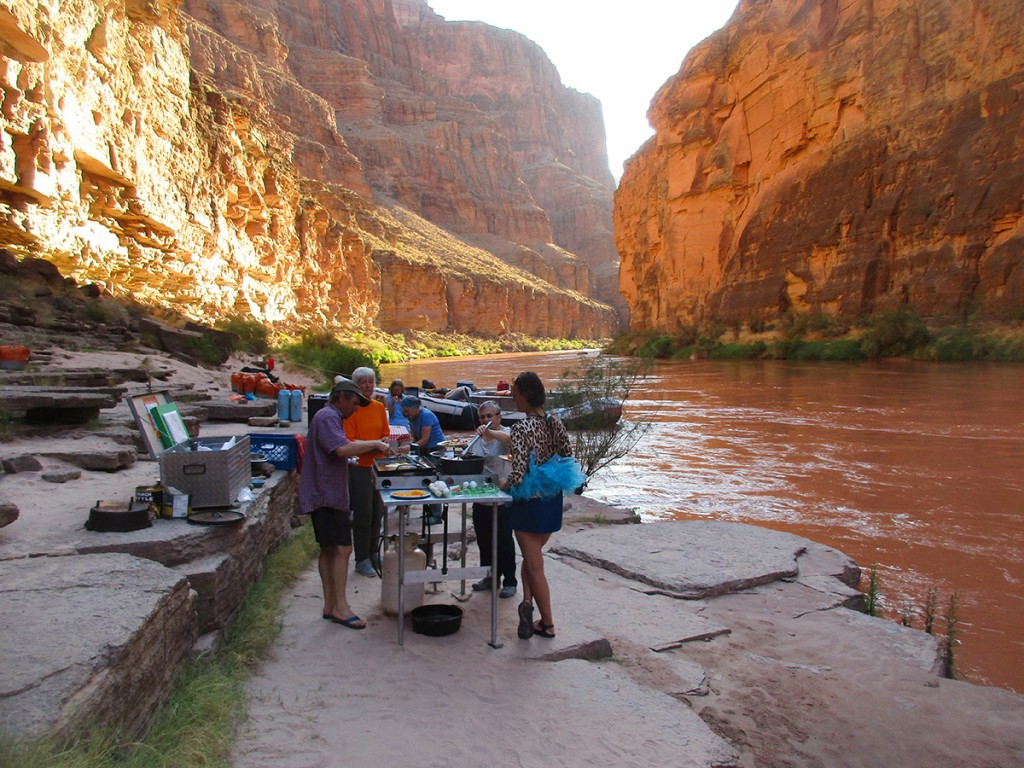
PHOTO: Lars cooking up breakfast in the morning after the flash flood. Note the change in the color of the water from the photo above. Photo courtesy of Jacque Miniuk.
We woke on the seventh day, yet there was no rest from all the work to be done. The river flowed gently again, as if the flood never happened, but the most violent rapid in the Grand Canyon, Lava Falls, waited downstream. Water there plummets over ancient basalt rocks scattered across the riverbed, dropping 37 feet in height in about 750 feet in distance around holes deep enough to swallow a two-story house. To the outside world, it’s a waterfall. To the rafting community, it’s a bucking class 10 rapid. Or, a test of survival. We’d face our fate in twenty-one miles.
We loaded the boat and chased reflections of cliffs and light between the narrow, near-vertical walls of the canyon for the rest of the morning. From my seat near the back of the boat, I wrapped my feet toe to ankle in athletic tape before slipping into my Death Shoes. Our guests dipped their sarongs and bandanas and hats in the fifty-one-degree water to stay cool. The river stained everything red.
The overnight flood gave us something new to do as we floated: sort through river booty. River booty is like pirates’ booty, except it’s the Colorado River that plunders the goods. The most highly-sought after treasure? An unopened beer chilled by the river herself. And also my missing shoe.
We spied a brim of a hat, half of a gnawed-up bailing sponge, even a torn-up captain’s chair, all drifting by. I pointed to another object bobbing off in the distance. “Lars, what is that? Is that a beaver or a river otter or a . . . ?”
“No. That there is the elusive Grand Canyon gator, the rarest species of alligator in all the world,” Lars said. The rounded head with a long snout swam closer to us.
“Lars! That’s a piece of wood,” I said, rolling my eyes.
“How do you know when a river guide is lying?” Josh said. He didn’t wait for a response. “His lips are moving.”
“That joke is older than Vishnu Schist,” I groaned, referring to the billion-year-old rock exposed in the Inner Gorge of the Grand Canyon.
“Don’t take that schist for granite, swamper,” Josh said. Zoroaster Granite, which is equally as old, criss-crosses the Vishnu Schist formation.
We stretched our legs on a short hike into National Canyon, a narrow side canyon, then continued floating downstream. We pulled into a sandy beach around river mile 168. “Lunchtime!” Lars yelled from the back. “Colleen, tie us off.”
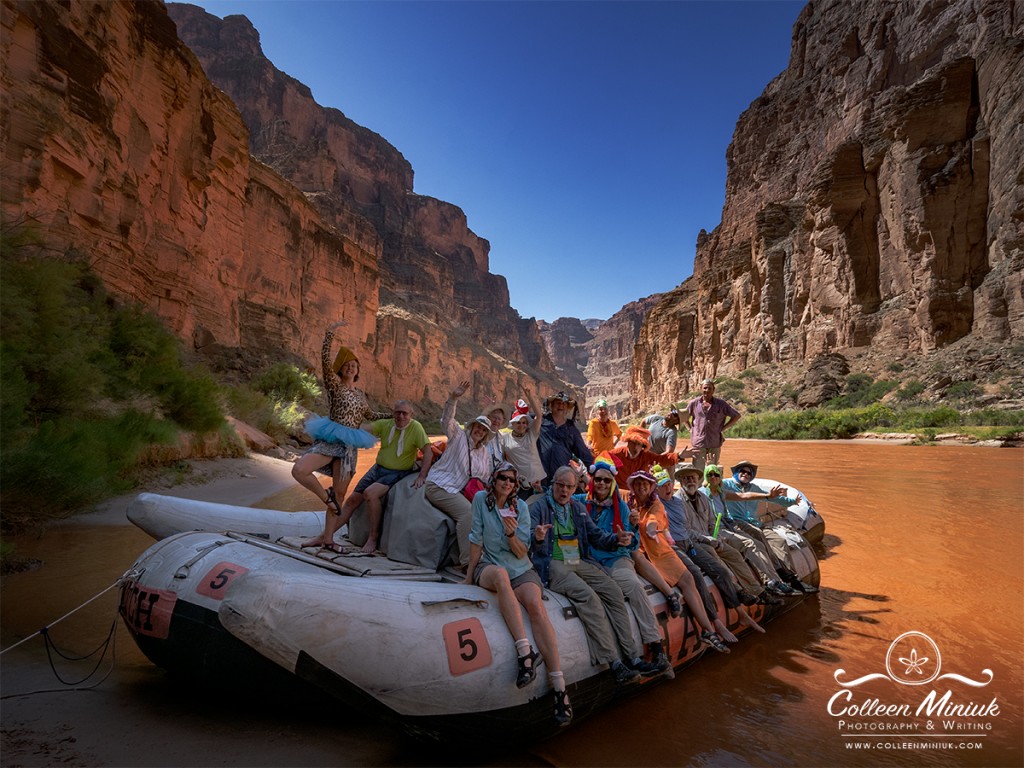
PHOTO: Our group of river rafters at lunch at mile 168 before hitting Lava Falls. Note the tutu (while wearing the Death Shoes).
Another river guide pop quiz! I grabbed a two-foot-long sand anchor, then tiptoed along the right boat tube, careful not to fall in. I unraveled the rope at the front of the boat, then marched twenty or so feet up the beach. After pushing the metal spike into the soft sand, I tied a well-dressed knot.
I too was well-dressed, and feeling it. I was wearing my lucky blue tutu. For Lava.
Lars inspected my work, kicking the three inches protruding out of the sand. “The first rule of being a river guide is to make sure you’ve pounded the sand anchor all the way into the sand. Otherwise the boat will drift downriver. Trip’s over. Then what will you say to your clients?”
“I thought the first rule was to keep shoes on my feet,” I said, pressing down on the anchor with the ball of my foot.
“That is the first rule.”
“Then this would be the second?”
“No. It’s also the first.” Lars bounded onto the boat.
“Let me guess. All the rules for being a river guide are first?”
“You’re catching on quick there, swamper.”
“How is that even possible? If all the rules are first, then none of them are,” I said, taking an armful of food from him to set up on the beach.
“Law of the river.”
“Created by who?”
“Me.”
“Oh right. I forgot. Lars’s Law of the River.”
For lunch, our group smashed peanut M&M’s into peanut butter and jelly sandwiches, devoured our twenty-seventh tube of Pringles, and slunk from one patch of shade to another as the sun cast shadows of willow and tamarisk across the shore. We didn’t linger. Lava loomed twelve miles ahead.
After a bouncy ride through Fern Glen Rapid, a class 2, Lars cut the motor, looked at me, and asked, “How do you approach Lava?”
I had studied many historical explanations in the Great Library of Almighty River Knowledge—the internet—of how to run Lava. Seven days of river time, withdrawn from technology, though, had turned my brain to mush. I couldn’t remember.
“Very carefully?” I said, laughing. When I saw he wasn’t joking, I straightened up.
“Follow the bubble line?” The easiest way through a rapid usually entails following the bubble line through its smooth V-shaped tongue.
“You’ll drop over the Ledge Hole and die,” Lars said. “Do you go left or right of the bubble line?”
I had a fifty-fifty chance. “Um. Left?”
“You die.”
I winced. I hadn’t kept count of all the ways I could have died so far, but I was starting to wonder if talking with Lars was dangerous to my health.
“Then right!” I said.
“Hug the right side to avoid the Ledge Hole,” Lars said. “But stay left so you don’t get sucked into the Pourover.”
Maneuvering a boat, especially one the size of a small barge, down the narrow navigable channel between the Ledge Hole and the Pourover requires a surgeon’s precision. The Ledge Hole, on the left, spans almost half the river. The Pourover, on the right, tumbles over a smaller, but no less dangerous, pit closer to shore. Rafters must punch through what sits between, the Hump Wave, a long, feisty lateral wave they fear—until they see what’s next.
“Then get ready for two more big hits,” Lars said. “First, the V-Wave. Don’t get turned around there, otherwise you’ll end up in the Corner Pocket on the right. Then, T up for Big Kahuna.”
First, the V-Wave. Its two lateral waves form the open jaws of a laughing hyena lying on its side. The teeth of the two waves devour boats that aren’t angled right. Then the hyena laughs and keeps frothing at the mouth. The alternative is to take a spin in Corner Pocket, where the swirling current holds rafts hostage and shreds them against Cheese-Grater Rock. It’d take a boat as long to get out of Corner Pocket as it would a dead body to resurface there. Maybe longer. And likely in worse condition.
Then it’s Big Kahuna. “Kahuna” is a Hawaiian word for sorcerer or wizard. That wave is a magician all right. It makes rafts disappear. Boats spill into a trough so deep they vanish from view. Seconds later, they crash into a ten-foot standing wave. If your boat hasn’t folded into a human taco once you hit what feels like a slab of concrete, then it stays submerged underwater as it plows through the crest. Lucky rafters resurface eventually. Smart ones bring a snorkel.
Lars revved the engine and off we went to meet our doom. From a quarter mile away, the roar of Lava echoed through the canyon. Soon after, the bubbling cauldron came into view, foaming and cackling. We made the requisite offerings to the river. Circled around Vulcan’s Throne. Looked up at the small arch on river right, the canyon’s Eye of Horus. Tightened down boat straps, life vests, and butt cheeks.
“It might get a little splashy,” Lars said, which is code for “Hang on. We might die.”
He led us into the maw to the right of the bubble line and executed the plan to perfection. In eighteen seconds, it was over: just like that, we were through Lava Falls. The Ritual of Aqua commenced. Hooting and hollering. Exaggerating the size of Big Kahuna. Cleaning fish out of our ears. Our boat had busted a tube strap in the V-Wave, but Lars blamed that on me wearing a tutu.
We spent a few minutes watching other boats take their turn down Lava, then turned to putt-putt downstream to our final camp at Whitmore Wash. After a mile or two, excitement melted into melancholy. Chatter silenced. No one wants a river trip to end.
“Hey, look over there! What is that?” someone suddenly yelled from the front of the raft, someone obviously still on river booty duty. I stood up thinking it would give me a clearer view of the sighting.
“Lars! THAT’S MY SHOE! I mean . . . ” I turned to him and changed my voice to mimic his. “That there is the elusive Colorado River croc, the rarest species of crocodile in all the world.”
Lars smiled. He circled around the eddy but couldn’t fit our boat’s big nose into the small gap between fallen boulders. He pulled into a longer eddy thirty feet downstream. Josh disembarked, then bushwhacked through tamarisk and rocks, jumping over at least two sleeping rattlesnakes, maybe three, to rescue my Croc with a fishing net. Back on board, he handed it to me and said, “Don’t lose this again.”
(VIDEO: Josh rescuing the Colorado River Croc: https://youtu.be/cw-S9p8Y0mo)
“My shoe made it through Lava all by itself!” I turned to Lars. “A successful solo run. On its first try!”
“I bet it stayed to the right of the bubble line,” Lars said, grinning.
“Of course it did. It’s my right shoe!”
My clients stood quiet on the tubes looking at me, Josh, Lars, each other, me. One eventually piped up, “So . . . yeah . . . how’d you lose your shoe?”
Before I could answer, Lars chimed in. “Did you know 87 percent of incidents in the Grand Canyon occur on shore? Of those, 96 percent involve alcohol.” He paused. “But 99 percent of statistics about river incidents are made up on the spot.”
“But, Lars, this isn’t a Croc of shit,” I said, waving my shoe in the air. “Remember, I’m a river guide in training. I have to end all river stories with ‘It’s all true.’”
This story originated from my participation in the Fishtrap Outpost writing workshop on the Snake River with Craig Childs. Much gratitude to the Outdoor Writers Association of America for granting me the prestigious 2019 John Madson Fellowship award, which provided financial support to enable me to experience the magic of Hells Canyon for the first time while honing my outdoor writing skills.

